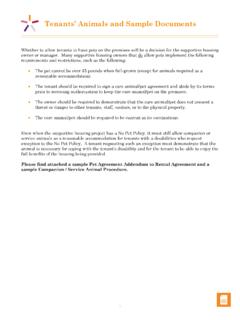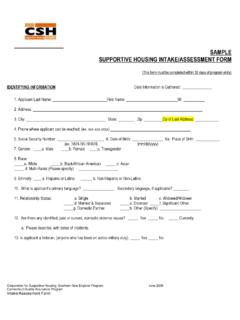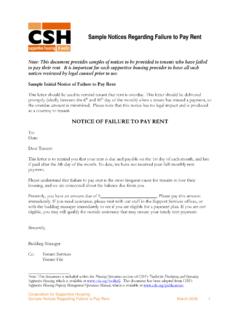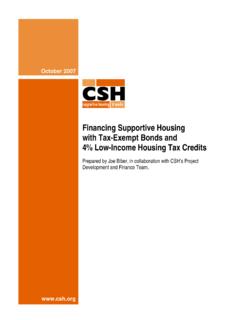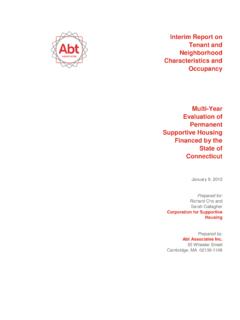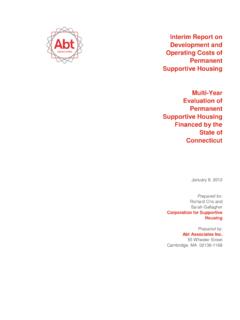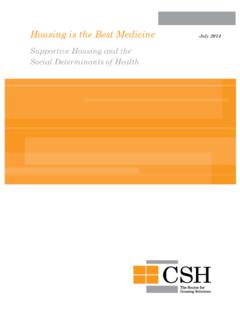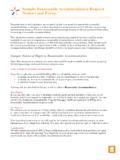Transcription of Sample Services Plan for a Mixed-Tenancy Supportive ...
1 Sample Services Plan for a Mixed-Tenancy Supportive housing Project This is a Sample plan for the provision of Supportive Services within an affordable housing development that includes units of Supportive housing . Organizations planning and operating Supportive housing projects may wish to use this plan as a template for the creation of their own service plans. Table of Contents 1. Introduction/Overview 2. Target Populations 3. Service Needs of the Target Populations 4. Supportive Service Design a. Overview b. Description of Services to Be Provided c. Staffing d. Outcomes 5. Budget and Staffing Plan 6. Marketing and Fair housing 7.
2 Addenda 1. Sample Services Plan for a Mixed-Tenancy Supportive housing Project | August 2013. 1. Introduction/Overview ABC housing Corporation, the Sponsor, is developing Nice Apartments in the South of Market neighborhood (SOMA) of San Francisco. SOMA has traditionally been the home to low and extremely low income persons, many of whom are homeless or at-risk of homelessness. The widespread development of high-end, market rate housing in the area over the past decade has driven up housing costs and resulted in widespread displacement of this population and the Services that support them. In order maintain the diversity of the SOMA community and offer housing options for the homeless residents of the area, it is important to create Supportive housing in this neighborhood.
3 To this end, Nice Apartments will include 98 units of service-enriched housing targeted to homeless and at-risk households, many of whom will also have other special needs. The project will have 3,200 square feet of internal common space that will be used for on- site social Services for tenants, including service coordination, case management, and educational Services . The Sponsor, through its Tenant Services Coordinator Program (TSCP), will provide overall service coordination for Nice Apartments. ABC has partnered with DEF Services and GHI. Services to provide the intensive case management that many of the project's tenants will require.
4 It is ABC's goal to create a service delivery system that can adapt to the changing needs and circumstances of the tenants during initial occupancy and throughout the life of the project. 2. Target Populations ABC has developed the Nice Apartments for the purpose of primarily serving single individuals and families who are homeless or who are at-risk of homelessness by virtue of their low incomes. Many of these homeless and at-risk households will also have special needs, including, but not limited to mental illness, co-occurring mental illness and substance use issues, physical disabilities, developmental disabilities, HIV/AIDS, and domestic violence issues.
5 Some of the tenants many also be youth exiting the foster care system. The sponsor has devised a rent structure that is appropriate for the target populations. The Nice Apartments will consist of 98 units of housing : 33 studios, 55 one-bedrooms, 8 two-bedrooms, and 2. manager's units. ABC has obtained financing through the Low Income housing Tax Credit Program (LIHTC), the San Francisco Mayor's Office of housing (MOH), and the State of California's Multifamily housing Program (MHP) for all 98 units. With these funding sources, ABC has been able to establish very affordable rents: 48 of the units will have rents affordable to households at approximately 27% of area median income (AMI) 1 and 50 will have rents affordable to those at 60% of AMI.
6 In addition, 24 of the 60% units will also have project-based Section 8. housing Choice Voucher subsidies from the San Francisco housing Authority, making them affordable to persons with incomes as low as 0% of AMI. ABC has also applied for HUD. Continuum of Care rental assistance funding for another 20 units, and expects to receive this funding. 1 Per the MHP funding, these units are affordable to households at 40% State Median Income (SMI), which when converted to AMI is approximately 27%. 2. Sample Services Plan for a Mixed-Tenancy Supportive housing Project | August 2013. The MHP funding requires that at least 74 of the units be occupied by households with Special Needs.
7 2 Additionally, financing from the Mayor's Office of housing requires that the units serve persons who are homeless or at-risk of homelessness and/or disabled. Based on the rent structure and financing requirements, ABC has developed the following more detailed description of the target populations and projected numbers of persons to be housed at the Nice Apartments. 3. Homeless Persons with Disabilities and Homeless Families. The 20 Continuum of Care units will be targeted to homeless individuals with disabilities (including mental illness, substance use issues, physical disabilities, HIV/AIDS and other chronic health conditions).
8 And to homeless families (including families in which one or more member has a disability). It is estimated that about half of these households will meet HUD's definition of chronic homelessness. These households are expected to be earning between 0% and 20% of AMI. Developmentally Disabled Individuals. Approximately 10 units will be targeted to individuals with Developmental Disabilities, the majority of whom will also be at-risk of homelessness due to their extremely low incomes. Extremely Low Income Individuals and Families At-Risk of Homelessness. Approximately 40 units will be targeted to single individuals and families who are at-risk of homelessness due to their very low incomes (these households will be between 10% and 27% of AMI).
9 Many will also have other special needs (such as disabilities or domestic violence issues). and may include youth aging out of the foster care system. Low Income Individuals and Small Families. Approximately 26 of the units will be targeted to the working poor, meaning single individuals, couples or small families earning no more than 60% of AMI. It is estimated that there will be approximately 20 children in the project, mostly in the two- bedroom units. A few of the one-bedroom units many house a single parent and child. 2 Special Needs is defined as: disabled households, agricultural workers, single-parent households, victims or survivors of domestic or physical abuse, households enrolled in Welfare-to-Work programs, homeless persons, or persons at risk of becoming homeless, chronically ill persons including those with HIV and mental illness, displaced dependent parents (or expectant dependent parents), emancipated foster youth, individuals exiting from institutional settings, chronic substance abusers, or other specific groups with unique housing needs as determined by the Department.
10 Special Needs Populations' do not include seniors or the frail elderly unless they otherwise qualify as Special Needs Population. (California Code of Regulations, Title 25, Division 1, Chapter 7, Subchapter 4, Article 2, Sec. 7301, gg). 3 These figures are estimates only. While ABC is targeting particular populations, Fair housing law requires that income-qualified households not be unfairly excluded simply because they do not fit a special needs category. Additionally, the tenants of the Section 8. units must be drawn from the San Francisco housing Authority's Section 8 Waiting List, and it is not possible to determine in advance exactly what the income levels and special needs of those households will be.
